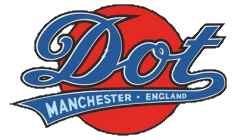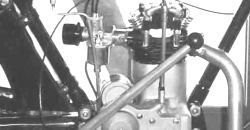


H. Reed and Co.
(Stand 163).
Two examples of the Dot motor cycles, which hail from Manchester. Both complete machines on the stand are fitted with 5 1/2 h.p. twin-cylinder Peugeot engines. Brown and Barlow carburetter, and belt transmission. The frames are unusually low, well under 30in. from top of saddle to the ground. The tanks are circular with a torpedo front, and the complete machines look very smart indeed, although occupying rather a bad position in the Arcade entrance, where prospective buyers are not tempted to linger in the somewhat strong air currents prevalent in this portion of the building.
1908 Harry Reed won the twin-cylinder class of the TT, and continued to race successfully until 1924. The road range was typical of the era and the engines used were Peugeot, JAP and Precision - singles and V-twins. Over the years the transmission gradually improved.
1915 By now, only JAP engines were fitted, along with Albion or Jardine gearboxes with two, three or four speeds.
Post Great War. A small range appeared comprising a single and two twins.
1923 The JAP-powered models were joined by a model fitted with the 348cc oil-cooled ohv Bradshaw engine.

British Engine Builder
Fitted to numerous British and European motorcycles.
Bradshaw Engines
1924 The range expanded still further with the addition of a model fitted with the same size Blackburne engine, one with an ohv JAP V-twin engine and another with a similar Anzani. Harry Reed came second in the Sidecar TT.
1924 Motorcycle. Exhibit at Manchester's Museum of Science and Industry.
1925 The range shrank to three 350cc models.
1926 The range remained the same until Harry Reed left the firm that year, at the age of fifty. It then passed to new owners who expanded the range.
1927 The range expanded still further with the introduction of several two-strokes of different capacity that ran alongside the various four-strokes.
1928-1932 The Depression years caused the range to shrink rapidly.
1928 Commenced using Villiers engines.
1932 Manufacture ceased after 1932 and the company changed hands yet again, when Bernard Wade took over.
Post World War II. The Dot name re-surfaced with the production of a three-wheeled motorcycle truck fitted with a 122cc Villiers engine.
1949 A single road model was launched. It was fitted with a 197cc Villiers engine unit and this spawned a series of mainly competition machines, with further road models following on.
1951 A new model appeared and this differed from all the previous ones as it had a 248cc Brockhouse sv engine.
1956 The Mancunian model was marketed. This had a Villiers 9E engine.
1957 Dot-Vivi mopeds were added to augment the range. These were imports built by the Italian firm Viberti which were fitted with 48cc engines from Victoria of Germany, with whom Viberti had an agreement.
1959 Yet another model was listed. This was fitted with a 349cc RCA twin two-stroke, but it, along with the Mancunian was short-lived. The range then became trials and scrambles models in various combinations. The company also sold the Dot-Guazzoni two-stroke moped from Italy, in a variety of engine sizes.
1962 The mopeds were dropped and the motorcycle range had already started to shrink.
1968 Worsening trade meant that machines were only available in kit form. The supply of Villiers engines dried up and in the final years the firm used the Italian 170cc Minarelli unit until the latter half of the 1970s.
1977 Small numbers of the above machines were built until that year.
1978 The company then used a Villiers-type 246cc engine that was built by DMW, when B. S. Wade showed his final creation to interested parties. It featured MP-style forks, a restyled frame and smaller hubs. DMW had bought the rights to the Villiers engine, and it looked similar to the 37A but had "DMW" on the chain case, and the engine covers were finished in black. However, the availability of Spanish trials machines meant that their efforts came to nothing and production ceased.
Note: After motorcycle production stopped, the firm continued their business by producing shock absorbers for cars and motorcycles under the Dot-Armstrong name.
Sources: Graces Guide; Cycling Aug 20, 1958.
If you have further information or a query related to this page, please contact us